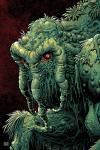|

By Jim Beard
From 1974 to 1975, legendary comics scribe Steve Gerber wove a series of macabre tales around one of Marvel’s strangest and most unique creations, the muck monster known as Man-Thing. Following Gerber’s death in 2008, fans mourned the reality that the writer would no longer be able to return to the character for one last story—until now.
INFERNAL MAN-THING, a three-issue limited series beginning in June, will present the final Steve Gerber Man-Thing tale, a previously-unknown story that until recently remained only a wishful thought in the hearts and minds of his devotees. To illustrate such a landmark series, Marvel has brought in the equally-acclaimed Kevin Nowlan.
“I was intrigued,” says the artist of his reaction upon first hearing of the script. “I'd read the story that preceded it, ‘Song-Cry of the Living Dead Man’ back in the 70's and remembered the characters as well as the trippy, stream-of-consciousness narrative. Later, Steve said he was disappointed in the ending and wanted to go back and conclude the story as he'd originally intended. I think that's what inspired this story.
“As a reader, I assumed he was writing about his own inner, emotional life. He found all those wildly creative techniques for making his ideas work in the context of a ‘horror’ story. I don't think there was anything comparable at the time; at least not in comics. We had super-heroics and soap opera and mystery and monsters, but Gerber was writing those wild, introverted stories about existential angst.”
Nowlan, who notes that he’s not just a fan of Steve Gerber's writing in general, but specifically his work on Man-Thing, reports that the new story, “Screenplay of the Living Dead Man” continues in the same narrative vein that the writer tapped so uniquely and successfully in his career.
“The main character's violent struggle against his own mind,” he says of what stands out in INFERNAL MAN-THING. “On the surface, it’s ‘comic’ violence but it's painful and grotesque. I don't want to give away too much because there should still be some surprises for the reader. Smaller details of the protagonist's life will seem familiar to anyone who knows a little about Steve's career. There are a few, vaguely autobiographical moments. Some cartoon characters come to life. That's a Steve Gerber trademark.”
When Nowlan sat down to bring his own visuals to the series, he claims to have fit them to the era in which the story first found life.
“I started with a 70's approach,” he notes. “I'm a little obsessed with comics from 1967-1974 so that's usually my starting point. I also decided early on that even though each page would be a full-color painting, I'd still use a strong black outline on the figures. I wasn't going for a photo-realistic approach so there didn't seem to be any reason to give up the sharpness and clarity that the black line gives to comic art.
“But the setting is a Florida swamp at night so the backgrounds are hazy and soft-focused. That's where I took advantage of the watercolor effects.”
One of the original Man-Thing series’ artists also proved inspirational for Nowlan on INFERNAL MAN-THING.
“MAN-THING #5, ‘Night of the Laughing Dead’ was the first Gerber story that I remember reading,” he says. “He was really finding his own voice. That's when we started to see the supernatural elements as surrogates for emotional conflicts. Having the perfect artist [in] Mike Ploog didn't hurt either. I love the stories they did together. Steve worked well with other artists but I thought that Mike was the definitive Man-Thing artist. Ploog drew people—and monsters—[that] were pulled down by gravity.”
As to what Steve Gerber might’ve thought about his final Man-Thing story finally seeing publication, the artist feels he cannot possibly know for certain, but there’s a definitely an open-minded wish there that the writer would be pleased.
“I hope he would have been happy,” Nowlan says. “Maybe a little annoyed that it took so long.”
|








